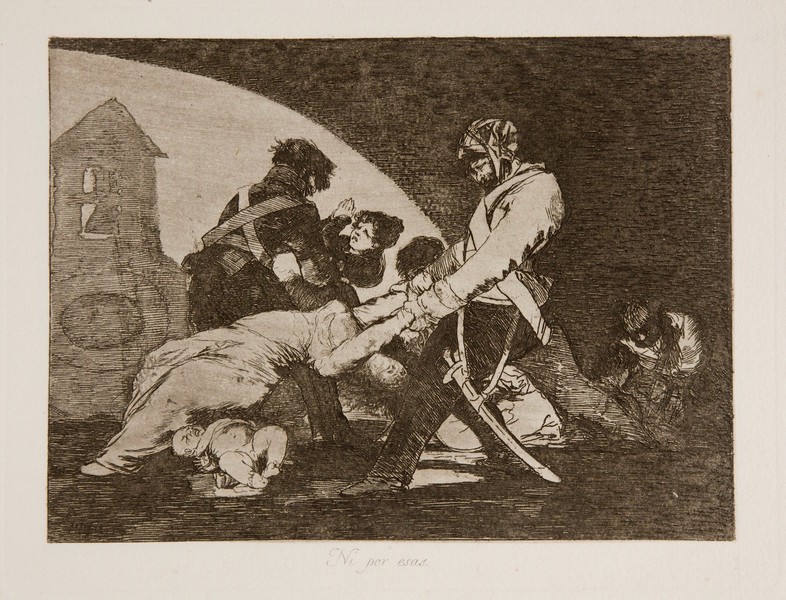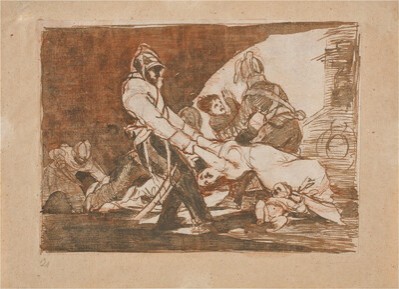- Cronología
- Ca. 1810 - 1815
- Dimensiones
- 161 x 211 mm
- Técnica y soporte
- Etching, lavis, drypoint and burin
- Reconocimiento de la autoría de Goya
- Undisputed work
- Ficha: realización/revisión
- 29 Nov 2010 / 02 Jun 2023
- Inventario
- 225
Goya (lower left-hand corner), 18 (lower left-hand corner).
See Sad presentiments of what must come to pass.
There exist several state proofs of this etching. In the first of these, Goya uses drypoint on the left leg of the woman in the foreground and some retouching has been done with the burin on the trousers worn by the soldier on the left. In the second state proof he extends the lavis work right out to the edges of the plate. In the third, the number of the plate, 18, is added. And in the last state proof, the definitive number, 11, is added, and the lavis work around the edges is removed.
The title was handwritten by Goya on the first and only print run that we know to have been made at the time, and which the painter gave to his friend Agustín Ceán Bermúdez. The title was engraved on to the copperplate at a later date, and no other modifications were made to the image for the first edition of the Disasters of War, which was printed by the Royal Academy of Fine Arts of San Fernando, Madrid, in 1863.
There is a preparatory drawing in the Prado Museum
Under a bridge, a French soldier, seen in profile, has seized a woman by the arms and is forcefully pulling her along. Next to her, on the ground, a naked baby is crying helplessly. In the middle ground another woman is being violently attacked by a second French soldier, his back turned to the viewer. In the background, through the arch, we can see a church, providing us with more context than is available in many of the other prints in the series. In the lower right-hand corner of the image Goya has depicted a figure, most likely a man, crouching down on the ground. Probably a relative of one of the women, this person is about to bear witness to the scene of rape that will surely follow these women's capture.
Or these continues the depiction of violence against women that Goya began in etchings no. 9, They do not want to and no. 10, Not in this case either. In each of these images the artist draws our attention to the bravery and courage of the women in resisting the assaults of the French soldiers. They do not form a narrative but rather show three isolated incidents, similar in nature and linked by a shared analogy. It is impossible to imagine a happy ending to these scenes, in which brute strength imposes itself inexorably.
This particular print is darker than many others in the Disasters of War series. Goya is clearly alluding to the fact that the scene is taking place in a remote spot, where the women have no hope of being rescued. Closing off the space is an archway that recalls the architectural structure in the artist's painting Interior of a Prision. In this shadowy setting, the whiteness of the soldier's dress coat, the woman's clothes, the body of the child and the face of the female figure in the middle ground make these elements stand out sharply.
The image of a child crying inconsolably, separated from its mother, was also represented by Goya in the painting Scene of Kidnapping and Murder, in which we see a bandit seizing a woman by the arms, just as occurs here in Or these.
Other etchings in which Goya addresses the role of women in war are no. 4, The women give courage, nº 7, What courage!, nº 9, They do not want to, nº 13, Bitter presence, nº 19, There is no more time and nº 31, That's tough!.
The etching plate is conserved in the National Chalcography Museum (cat. 262).
-
Goya and his timesThe Royal Academy of ArtsLondon1963cat. 66cat. 234
-
Goya. Das Zeitalter der Revolucionen. Kunst um 1800 (1980 – 1981)Hamburger KunsthalleHamburg1980cat. 74
-
Francisco de GoyaMuseo d'Arte ModernaLugano1996exhibition celebrated from September 22nd to November 17th.p. 128, cat. 11
-
Francisco Goya. Sein leben im spiegel der graphik. Fuendetodos 1746-1828 Bordeaux. 1746-1996Galerie KornfeldBern1996from November 21st 1996 to January 1997cat. 99
-
Ydioma universal: Goya en la Biblioteca NacionalBiblioteca NacionalMadrid1996from September 19th to December 15th 1996cat. 216
-
Francisco Goya. Capricci, follie e disastri della guerraSan Donato Milanese2000Opere grafiche della Fondazione Antonio Mazzottacat. 91
-
Goya. La imagen de la mujerMuseo Nacional del PradoMadrid2001from October 30th 2001 to February 10th 2002. Exhibitied also at the National Gallery of Art, Washington, March 10th to June 2nd 2002, consultant editor Francisco Calvo Serrallercat. 109
-
Goya. Opera graficaPinacoteca del Castello di San GiorgioLegnano2006exhibition celebrated from December 16th 2006 to April 1st 2007p. 56
-
Goya en tiempos de guerraMuseo Nacional del PradoMadrid2008consultant editor Manuela B. Mena Marqués, from April 14th to July 13th 2008cat. 87
-
Goya luces y sombrasCaixaForumBarcelona2012consultant editors José Manuel Matilla and Manuela B. Marqués. From March 16th to June 24th 2012cat. 51
-
Goya et la modernitéPinacothèque de ParisParís2013from October 11st 2013 to March 16th 2014cat. 50
-
2022
-
Goya, grabadorMadridBlass S.A.1918cat. 113
-
Goya engravings and lithographs, vol. I y II.OxfordBruno Cassirer1964cat. 131
-
Vie et ouvre de Francisco de GoyaParísOffice du livre1970cat. 1007
-
Catálogo de las estampas de Goya en la Biblioteca NacionalMadridMinisterio de Educación y Cultura, Biblioteca Nacional1996cat. 199
-
ParísPinacoteca de París2013p.125
-
Museo de Bellas Artes de Badajoz y Diputación de Badajoz2022p. 58
-
Goya. In the Norton Simon MuseumPasadenaNorton Simon Museum2016

